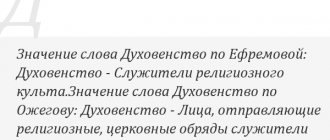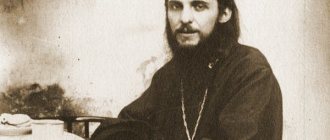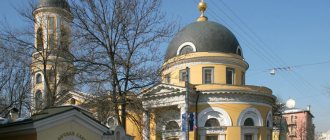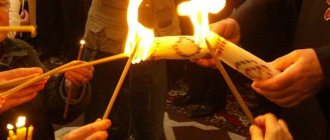The white clergy includes married clergy who did not take monastic vows. They are allowed to have a family and children.
When they talk about the black clergy, they mean monks ordained to the priesthood. They devote their entire lives to serving the Lord and take three monastic vows - chastity, obedience and non-covetousness (voluntary poverty).
A person who is going to take holy orders is required to make a choice even before ordination - to marry or become a monk. After ordination, a priest can no longer marry. Priests who did not marry before being ordained sometimes choose celibacy instead of becoming a monk—they take a vow of celibacy.
In Orthodoxy there are three degrees of priesthood. At the first level are deacons. They help conduct services and rituals in churches, but they themselves cannot conduct services or perform sacraments. Church ministers belonging to the white clergy are simply called deacons, and monks ordained to this rank are called hierodeacons.
Among the deacons, the most worthy can receive the rank of protodeacon, and among the hierodeacons, the eldest are archdeacons. A special place in this hierarchy is occupied by the patriarchal archdeacon, who serves under the patriarch. He belongs to the white clergy, and not to the black clergy, like other archdeacons.
The second degree of priesthood is priests. They can independently conduct services, as well as perform most of the sacraments, except for the sacrament of ordination to the priesthood. If a priest belongs to the white clergy, he is called a priest or presbyter, and if he belongs to the black clergy, he is called a hieromonk.
A priest can be elevated to the rank of archpriest, that is, senior priest, and a hieromonk - to the rank of abbot. Often archpriests are the abbots of churches, and abbots are the abbots of monasteries.
The highest priestly rank for the white clergy, the title of protopresbyter, is awarded to priests for special merits. This rank corresponds to the rank of archimandrite in the black clergy.
Priests belonging to the third and highest degree of priesthood are called bishops. They have the right to perform all sacraments, including the sacrament of ordination of other priests. Bishops govern church life and lead dioceses. They are divided into bishops, archbishops, and metropolitans.
Only a clergyman belonging to the black clergy can become a bishop. A priest who has been married can be elevated to the rank of bishop only if he becomes a monk. He can do this if his wife has died or has also become a nun in another diocese.
The local church is headed by the patriarch.
Every Orthodox person meets with clergy who speak publicly or conduct services in church. At first glance, you can understand that each of them wears some special rank, because it’s not for nothing that they have differences in clothing: different colored robes, hats, some have jewelry made of precious stones, while others are more ascetic. But not everyone is given the ability to understand ranks. To find out the main ranks of clergy and monks, let's look at the ranks of the Orthodox Church in ascending order.
It should immediately be said that all ranks are divided into two categories:
- Secular clergy. These include ministers who may have a family, wife and children.
- Black clergy. These are those who accepted monasticism and renounced worldly life.
Secular clergy
The description of people who serve the Church and the Lord comes from the Old Testament. The scripture says that before the Nativity of Christ, the prophet Moses appointed people who were supposed to communicate with God. It is with these people that today's hierarchy of ranks is associated.
Altar server (novice)
This person is a lay assistant to the clergy. His responsibilities include:
If necessary, a novice can ring bells and read prayers, but he is strictly forbidden to touch the throne and walk between the altar and the Royal Doors. The altar server wears the most ordinary clothes, with a surplice thrown over the top.
This person is not elevated to the rank of clergy. He must read prayers and words from scripture, interpret them to ordinary people and explain to children the basic rules of Christian life. For special zeal, the clergyman can ordain the psalmist as a subdeacon. As for church clothes, he is allowed to wear a cassock and a skufia (velvet cap).
This person also does not have holy orders. But he can wear a surplice and an orarion. If the bishop blesses him, then the subdeacon can touch the throne and enter through the Royal Doors into the altar. Most often, the subdeacon helps the priest perform the service. He washes his hands during services and gives him the necessary items (tricirium, ripids).
Spiritual orders and ranks
The original meaning of the word “Church” is a gathering of Christ’s disciples, Christians; translated as “meeting”. The concept of “Church” is quite broad: it is a building (in this meaning of the word church and temple are one and the same!), and a meeting of all believers, and a regional meeting of Orthodox people - for example, the Russian Orthodox Church, the Greek Orthodox Church.
Also, the Old Russian word “cathedral”, translated “assembly”, still refers to congresses of the episcopate and lay Christians to this day (for example, the Ecumenical Council is a meeting of representatives of all Orthodox regional Churches, the Local Council is a meeting of one Church).
The Orthodox Church consists of three orders of people:
- Laymen are ordinary people who are not ordained and do not work in the church (parish). The laity are often called “the people of God.”
- Clergy are laymen who are not ordained to the priesthood, but who work in the parish.
- Priests, or clergy and bishops.
First, we need to talk about the clergy. They play an important role in the life of the Church, but they are not consecrated or ordained through the Sacraments of the Church. This category of people includes professions of different importance:
- Watchmen, cleaners at the temple;
- The elders of churches (parishes are people like the caretaker);
- Employees of the office, accounting and other departments of the Diocesan Administration (this is an analogue of the city administration; even non-believers can work here);
- Readers, altar servers, candle bearers, psalm-readers, sextons - men (sometimes nuns) who serve at the altar with the blessing of the priest (once these positions were different, now they are mixed);
- Singers and regents (church choir conductors) - for the position of regent you need to receive the appropriate education at a theological school or seminary;
- Catechists, diocesan press service employees, youth department employees are people who must have a certain deep knowledge of the Church; they usually complete special theological courses.
Some clergy may have distinctive clothing - for example, in most churches, except for poor parishes, male altar servers, readers and candle bearers wear brocade surplices or cassocks (black clothing is slightly narrower than the cassock); At festive services, choristers and directors of large choirs dress in freeform, custom-made, pious clothing of the same color.
Let us also note that there is such a category of people as seminarians and academicians. These are students of Theological schools - schools, seminaries and academies - where future priests are trained. This gradation of educational institutions corresponds to a lay school or college, an institute or university, and a postgraduate or master's degree. Students usually, in addition to studying, perform obediences in the church at the Theological School: they serve at the altar, read, and sing.
There is also the title of subdeacon. This is a person who helps the bishop in worship (taking out the staff, bringing a basin for washing hands, putting on liturgical clothes). A subdeacon can also be a deacon, that is, a clergyman, but most often it is a young man who does not have holy orders and performs only the duties of a subdeacon.
Church ranks of the Orthodox Church
All of the church ministers listed above are not clergy. These are simple peaceful people who want to get closer to the church and the Lord God. They are accepted into their positions only with the blessing of the priest. Let's start looking at the ecclesiastical ranks of the Orthodox Church from the lowest.
The position of deacon has remained unchanged since ancient times. He, as before, must help in worship, but he is prohibited from independently performing church services and representing the Church in society. His main responsibility is reading the Gospel. Currently, the need for the services of a deacon is no longer required, so their number in churches is steadily decreasing.
This is the most important deacon at a cathedral or church. Previously, this rank was given to a protodeacon, who was distinguished by his special zeal for service. To determine that this is a protodeacon, you should look at his vestments. If he wears an orarion with the words “Holy! Holy! Holy,” that means he’s the one in front of you. But at present, this rank is given only after a deacon has served in the church for at least 15–20 years.
It is these people who have a beautiful singing voice, know many psalms and prayers, and sing at various church services.
This word came to us from the Greek language and translated means “priest.” In the Orthodox Church this is the lowest rank of priest. The bishop gives him the following powers:
- perform divine services and other sacraments;
- bring teaching to people;
- conduct communion.
The priest is prohibited from consecrating antimensions and performing the sacrament of ordination of the priesthood. Instead of a hood, his head is covered with a kamilavka.
This rank is given as a reward for some merit. The archpriest is the most important among the priests and also the rector of the temple. During the performance of the sacraments, archpriests put on a chasuble and stole. Several archpriests can serve in one liturgical institution at once.
This rank is given only by the Patriarch of Moscow and All Rus' as a reward for the kindest and most useful deeds that a person has done in favor of the Russian Orthodox Church. This is the highest rank in the white clergy. It will no longer be possible to earn a higher rank, since then there are ranks that are prohibited from starting a family.
Nevertheless, many, in order to get a promotion, leave worldly life, family, children and go into monastic life forever. In such families, the wife most often supports her husband and also goes to the monastery to take monastic vows.
Church hierarchy
The priesthood, which emerged in the second century and continues to this day, is divided into 3 levels:
- The lowest level is occupied by deacons. They can participate in the performance of sacraments, help the highest ranks conduct rituals in churches, but they do not have the right to independently conduct services.
- The second level occupied by the clergy of the church is the priests, or priests. These people can independently conduct services, conduct all rituals with the exception of ordination (the sacrament during which a person acquires grace and himself becomes a minister of the church).
- The third, highest level is occupied by bishops, or bishops. Only monks can achieve this rank. These people have the right to perform all the sacraments, including ordination, and in addition, they can lead the diocese. Archbishops ruled larger dioceses, metropolitans, in turn, ruled a region that included several dioceses.
How easy is it to be a clergyman today? The clergy are those people who daily listen during confessions to many complaints about life, confessions of sins, see a huge number of deaths and often communicate with grief-stricken parishioners. Every clergyman must carefully think through each of his sermons; in addition, he must be able to convey holy truths to people.
The difficulty of the work of every priest is that he does not have the right, like a doctor, teacher or judge, to work the allotted time and forget about his duties - his duty is with him every minute. Let us be grateful to all the clergy, because for everyone, even the most distant person from the church, there may come a moment when the priest’s help will be invaluable.
The Christian clergy is divided into white and black. White clergy, or clergy, are deacons, priests, bishops and archbishops, and patriarchs. The white clergy must serve among the people—in the world. Deacons assist priests in church services. Priests are required to care for the souls of the inhabitants of a particular parish. A parish usually includes several villages or city blocks. In his parish, the priest conducts services, performs church rituals, confesses to parishioners, assigns them punishments for sins, and helps the poor. To maintain the church, parishioners had to pay a special tax - tithe. From the name itself it is clear that tithe is a tenth of income. At first, tithes were paid only from the harvest, but gradually the church began to take a share from livestock, and later from the income of the city's artisans. A relatively small part of the tithe remained in the parish and was spent: a) on the construction, repair and decoration of the parish church; b) to help the poor, wanderers, pilgrims, cripples; c) for the maintenance of the local clergy. The rest went to bishops, archbishops, and for other church needs. Several parishes were united into a bishopric with a bishop at its head. Several bishoprics become an archbishopric. In the East, large archbishoprics began to be called metropolises headed by metropolitans. Over time, the most important bishop in the West became the bishop of the city of Rome - the Pope. The first bishop of Rome was considered the Apostle Peter, one of the closest disciples of Jesus Christ. Therefore, the popes began to call themselves successors of the Apostle Peter. The two crossed keys of the Apostle Peter - silver and gold - became signs of papal authority. Another symbol of papal power is the tiara, which appeared, however, quite late, in the 14th century. The tiara is the ceremonial headdress of the Pope. The basis of the tiara is the miter - a special high hat that distinguished all bishops and archbishops. But the pope wears three crowns on his miter, one above the other. The three crowns should mean that the pope is the chief judge, the chief legislator and the chief clergyman of the entire Catholic world. Other distinguishing features of bishops, in addition to the miter, were a ring and a special part of the church vestment - the pallium. A special staff served as a sign of pastoral service for bishops and abbots. In the East, four major patriarchates arose with centers in Constantinople, Antioch, Jerusalem and Alexandria. Each patriarchate united many metropolises. Over time, the Patriarch of Constantinople, called the “ecumenical patriarch,” acquired the greatest importance. There was constant competition between him and the Pope for influence over Christians. If in the West the church tried to replace the collapsing government bodies, then in the East the church was part of a well-established state mechanism. Monasticism The black clergy, that is, monasticism (from the Greek word “monachos” - “single”), is also subordinate to the bishops, as well as the patriarchs and the pope. So that the bustle of the world does not interfere with prayer and reflection, monks withdraw from the world and settle in secluded places, for example, in the desert, deep forest or in the mountains. If monks have to settle, say, in a city, they fence off their monastery from the bustling city life with a high wall. Monks live either alone or together in communities - monasteries. St. Anthony the Great Monasticism was born in the 3rd century. in the East - in Egypt. The founder of monasticism is considered to be St. Anthony (c. 250-356). St. Anthony became a hermit at the age of 21. One day he was walking through the Egyptian desert. Suddenly he sees someone who looks like him sitting and working, then gets up to pray and gets back to work. It was, as legend says, an angel of God. “Do this and you will be saved,” the angel said to Anthony. Tireless work and fervent prayer became the main laws of hermit life. Christians, having heard about Anthony's holiness, settled next to him. This is how one of the first monastic communities arose. In the East, monasteries were called monasteries and laurels. St. Benedict and his Rule The founder of Western monasticism is considered to be St. Benedict, who lived in the first half of the 6th century. Following the example of Eastern monks, he created the first rules of monastic life in the West - the charter. “Pray and work!” - with these words of St. Benedict can briefly express the essence of his charter. In the West, large monasteries were called abbeys. They were headed by abbots. Schools and book copying workshops—scriptoria—began to appear at many monasteries. Often the time spent by a monk copying ancient manuscripts was counted as prayer time. Monasteries became important centers of education and culture in the early Middle Ages. Questions 1. Try to explain why the discussion of abstract theological issues sometimes took on a fierce character and aroused the widest interest? Why were not only learned monks and clerics, but even common people on the streets or city markets ready to argue until they were hoarse about who was right: Arius or his opponents? 2. Why were there differences between the Eastern and Western churches from the very beginning, and why did they continue to accumulate over time? 3. Why do you think that in Western Europe, it was in monasteries that many elements of ancient education and ancient culture were preserved?
Into two categories: white and black. The first category includes those priests who did not take the monastic vow, the second includes those who took it. Taking the vow occurs at the time of becoming a monk. Before taking holy orders, a person must decide who he wants to be: a priest (they are allowed to have a wife) or a monk. Once ordination is completed, marriage becomes impossible for the priest. In addition, there is a vow of celibacy. It means complete celibacy. Religion allows priests and deacons to have a spouse, but the hierarch must be a monk.
In Orthodoxy there are three hierarchical ranks:
- diaconate;
- priesthood;
- bishopric.
During services, priests are assisted by deacons. However, the latter are deprived of the right to conduct them without the participation of a priest, who, in turn, can perform almost all the sacraments. Bishops carry out ordination to the priesthood; in their hands is all the power that the church can give to a person. This is the highest degree of priesthood.
At the base of the hierarchical ladder are bishops, followed by archbishops in increasing power, then the metropolitan and, finally, the patriarch.
Black clergy
It includes only those who have taken monastic vows. This hierarchy of ranks is more detailed than that of those who preferred family life to monastic life.
This is a monk who is a deacon. He helps clergy conduct sacraments and perform services. For example, he carries out the vessels necessary for rituals or makes prayer requests. The most senior hierodeacon is called “archdeacon.”
This is a man who is a priest. He is allowed to perform various sacred sacraments. This rank can be received by priests from the white clergy who decided to become monks, and by those who have undergone consecration (giving a person the right to perform the sacraments).
This is the abbot or abbess of a Russian Orthodox monastery or temple. Previously, most often, this rank was given as a reward for services to the Russian Orthodox Church. But since 2011, the patriarch decided to grant this rank to any abbot of the monastery. During initiation, the abbot is given a staff with which he must walk around his domain.
This is one of the highest ranks in Orthodoxy. Upon receiving it, the clergyman is also awarded a miter. The archimandrite wears a black monastic robe, which distinguishes him from other monks by the fact that he has red tablets on him. If, in addition, the archimandrite is the rector of any temple or monastery, he has the right to carry a rod - a staff. He is supposed to be addressed as “Your Reverence.”
This rank belongs to the category of bishops. At their ordination, they received the highest grace of the Lord and therefore can perform any sacred rites, even ordain deacons. According to church laws, they have equal rights; the archbishop is considered the most senior. According to ancient tradition, only a bishop can bless the service with an antimis. This is a quadrangular scarf in which part of the relics of a saint is sewn.
This clergyman also controls and guards all monasteries and churches that are located on the territory of his diocese. The generally accepted address to a bishop is “Vladyka” or “Your Eminence.”
This is a high-ranking clergy or the highest title of bishop, the oldest on earth. He obeys only the patriarch. Differs from other dignitaries in the following details in clothing:
- has a blue robe (bishops have red ones);
- The hood is white with a cross trimmed with precious stones (the rest have a black hood).
This rank is given for very high merits and is a badge of distinction.
The highest rank in the Orthodox Church, the main priest of the country. The word itself combines two roots: “father” and “power”. He is elected at the Council of Bishops. This rank is for life; only in the rarest cases can it be deposed and excommunicated. When the place of the patriarch is empty, a locum tenens is appointed as a temporary executor, who does everything that the patriarch should do.
This position carries responsibility not only for itself, but also for the entire Orthodox people of the country.
The ranks in the Orthodox Church, in ascending order, have their own clear hierarchy. Despite the fact that we call many clergy “father,” every Orthodox Christian should know the main differences between dignitaries and positions.
The Orthodox clergy is a special class that appeared in Rus' in 988, after the Baptism of Rus'. History is silent about how the situation with the clergy was before this period, but it is known that the priest Gregory traveled with Princess Olga to Constantinople. At a time when the clergy was entrusted with a special and very important mission - the Christianization of the population, priests were considered a special and privileged class. Many came from Greece and Bulgaria; even children from different classes were selected for education as the future clergy. The monks enjoyed special honor and respect, and the ascetic culture turned out to be especially close to the people. Rich and noble people of that time went to the monastery. In addition, monasteries have always carried out charitable work. The princes favored the monasteries and freed them from taxes. No exact information has been preserved about who became the first Metropolitan of Kyiv. Since the 16th century, it was believed that he was Michael I the Syrian, who was once sent to perform the Sacrament of Baptism over Prince Vladimir. In Kyiv, he baptized local residents. The relics of Metropolitan Michael were kept in the Church of the Tithes, but then they were transferred to the Great Church of the Lavra.
Hierarchy of the white clergy
It is worth noting that the hierarchy of the clergy did not appear since the advent of the Church. At the dawn of Christianity, everyone was equal. Gradually, the need to distinguish between church titles and ranks became obvious. In the Russian Orthodox Church you cannot immediately “come to the position” of Metropolitan or Bishop. Such titles must be earned. We will tell you more about the role each clergy rank plays in the life of the Church in this article.
At the head of the Russian Orthodox Church is the Primate - the Patriarch of Moscow and All Rus'. Together with the Holy Synod, it administers church affairs.
Responsible for several dioceses at once. Bishops do not make important decisions without the knowledge of the Metropolitan.
Each diocese has its own Bishop, who is responsible for the area assigned to him. Absolutely all bishops belong to the black clergy. Bishops are responsible for large dioceses.
There are also deacons and protodeacons who assist the priest and archpriest during services. A deacon cannot conduct divine services on his own.
Thus, the hierarchy in the white clergy looks like this:
- Patriarch
- Metropolitan
- Bishop/Bishop
- Priest/Archpriest
- Deacon/protodeacon
How do white clergy differ from black clergy?
In the Russian Orthodox Church there is a certain church hierarchy and structure.
First of all, the clergy is divided into two categories - white and black. How are they different from each other? The white clergy includes married clergy who did not take monastic vows. They are allowed to have a family and children.
When they talk about the black clergy, they mean monks ordained to the priesthood. They devote their entire lives to serving the Lord and take three monastic vows - chastity, obedience and non-covetousness (voluntary poverty).
A person who is going to take holy orders is required to make a choice even before ordination - to marry or become a monk. After ordination, a priest can no longer marry. Priests who did not marry before being ordained sometimes choose celibacy instead of becoming a monk—they take a vow of celibacy.
In Orthodoxy there are three degrees of priesthood. At the first level are deacons. They help conduct services and rituals in churches, but they themselves cannot conduct services or perform sacraments. Church ministers belonging to the white clergy are simply called deacons, and monks ordained to this rank are called hierodeacons.
Among the deacons, the most worthy can receive the rank of protodeacon, and among the hierodeacons, the eldest are archdeacons. A special place in this hierarchy is occupied by the patriarchal archdeacon, who serves under the patriarch. He belongs to the white clergy, and not to the black clergy, like other archdeacons.
The second degree of priesthood is priests. They can independently conduct services, as well as perform most of the sacraments, except for the sacrament of ordination to the priesthood. If a priest belongs to the white clergy, he is called a priest or presbyter, and if he belongs to the black clergy, he is called a hieromonk.
A priest can be elevated to the rank of archpriest, that is, senior priest, and a hieromonk - to the rank of abbot. Often archpriests are the abbots of churches, and abbots are the abbots of monasteries.
The highest priestly rank for the white clergy, the title of protopresbyter, is awarded to priests for special merits. This rank corresponds to the rank of archimandrite in the black clergy.
Priests belonging to the third and highest degree of priesthood are called bishops. They have the right to perform all sacraments, including the sacrament of ordination of other priests.
Bishops govern church life and lead dioceses. They are divided into bishops, archbishops, and metropolitans.
Only a clergyman belonging to the black clergy can become a bishop. A priest who has been married can be elevated to the rank of bishop only if he becomes a monk. He can do this if his wife has died or has also become a nun in another diocese.
The local church is headed by the patriarch. The head of the Russian Orthodox Church is Patriarch Kirill. In addition to the Moscow Patriarchate, there are other Orthodox patriarchates in the world - Constantinople, Alexandria, Antioch, Jerusalem, Georgian, Serbian, Romanian and Bulgarian.
Hierarchy of the black clergy
The black clergy has its own rules:
The Patriarch is still considered the head of the Church. And the head of several dioceses is the Metropolitan. A diocese can be headed by a bishop or archbishop (for the largest dioceses). The abbot of a large monastery and the highest monastic rank is the Archimandrite. This status is given for special services to the Church. The abbot of the monastery, chosen by the hieromonks, is the abbot. Interestingly, a widower priest can also become an archimandrite after monastic tonsure. The inhabitants of the monasteries are Hierodeacons and Hieromonks.
The choice of faith today is a personal matter for everyone. Now the church is completely separated from the state, but a completely different situation developed in the Middle Ages. In those days, the well-being of both an individual and society as a whole depended on the church. Even then, groups of people were formed who knew more than others and could convince and lead. They interpreted the will of God, which is why they were respected and sought advice. What is the clergy? What was the clergy of the Middle Ages like, and what was its hierarchy?
What was the clergy like in Europe?
Society in those days was divided into three groups:
- feudal knights - those people who fought;
- peasants - those who worked;
- clergy - those who prayed.
At that time, the clergy was the only educated class. There were libraries at the monasteries, where the monks kept books and copied them; it was there that science was concentrated before the advent of universities. Barons and counts did not know how to write, so they used seals; peasants are not even worth talking about. In other words, the clergy is the definition of people who are capable of being mediators between God and the common people and are engaged in carrying out. The clergy is divided into “white” and “black”.
White and black clergy
The white clergy includes priests, deacons serving churches - these are the lowest clergy. They do not take a vow of celibacy, they can start a family and have children. The highest rank of white clergy is protopresbyter.
Black clergy means monks who devote their entire lives to serving the Lord. Monks give obedience and voluntary poverty (non-covetousness). Bishop, archbishop, metropolitan, patriarch are the highest clergy. A transition from white to black clergy is possible, for example, if the parish priest’s wife died, he can become a monk and go to a monastery.
In (and among Catholics to this day) all clergy took a vow of celibacy; the class could not be replenished naturally. How, then, could one become a clergyman?
Black and White Clergy: Serving God
The first representatives of the clergy in Rus' appeared during its baptism under Prince Vladimir. And for more than 1000-
Over the course of history, the Orthodox clergy became a fairly prominent class, especially before the revolution. Indeed, during the years of Soviet power, a very large number of clergy died in the camps. At the end of the last century, churches, monasteries, and seminaries began to open, and the number of clergy began to increase again. The clergy in the Russian Orthodox Church is divided into white (priests who have not taken monastic vows) and black (monastics). Monks take vows when they take vows. Before a person takes holy orders, he must decide whether he will become a monk or a married priest. After all, according to the rules, after ordination a priest can no longer marry. Celibacy is also possible - a vow of celibacy. In Orthodoxy, deacons and priests can be both married and monastics, while hierarchs can only be monastics. Orthodoxy has three ranks of hierarchy: diaconate, priesthood, and bishopric. Deacons are assistants to priests and bishops during divine services. But they themselves have no right to perform any sacrament without priests. Priests are clergy who have the right to independently perform almost all the sacraments (except for ordination to the priesthood - this is the prerogative of the bishop). Bishops are clergy of the highest degree of priesthood who have full power in the Church. The hierarchical ladder is as follows: bishop, archbishop, metropolitan, patriarch.
White clergy ranks
Representatives of the white clergy are closer to the laity, and in number they make up approximately three-quarters of the entire clergy. In almost every village there is an Orthodox church operating or being revived, while in cities there are several dozen parish churches. If the parish is small, then one priest serves. In large parishes, pastoral service is carried out by an archpriest, a priest, and a deacon. The clergy are helped by the laity. An altar boy is a man who helps the priest at the altar (another name is sexton, novice). Nowadays, his duties can be performed either by nuns or elderly single women due to the fact that there are not always believing men who want to serve the Lord in this way. Altar servers do not go through the sacrament, the rector simply blesses them to serve: to light candles and lamps in the altar and at the iconostasis in time, prepare vestments, bring prosphora, wine, incense, light the censer, serve cloths for wiping lips during Communion, tidy up the altar. Psalmist (or reader) is a rank of clergy that does not have the degree of priesthood. Readers read the Holy Scriptures and prayers aloud during the service. If necessary, abbots can give other obediences to the readers. In Orthodoxy, a layman, before becoming a reader, undergoes hirothesia - a rite of initiation into a bishop. Without this first ordination one cannot become a subdeacon, be ordained a deacon, and then a priest. A subdeacon is a clergyman who usually serves the bishop during his sacred rites: he carries candles, spreads the eagle, washes the bishop’s hands, and clothes. The subdeacon does not have a sacred degree, although he wears a surplice and wears an orarion - an accessory to the deaconate, symbolizing angelic wings. Deacon is the first degree of priesthood. Deacons assist priests during divine services, but do not have the right to perform the service themselves. Currently, not all churches have deacons; it is difficult for a small parish to support a large clergy. Protodeacon is the chief deacon in the cathedral. The title can be given after 20 years of service in the priesthood. Priest is the first title of a clergyman; the priest received the power to teach Orthodoxy to his flock, perform the Sacraments (except for the ordination of priests), and conduct services, including the Liturgy (except for the consecration of the antimension). Archpriest is a title given to a priest as a reward. The initiation into archpriest is carried out by the bishop during consecration. Protopresbyter is the highest rank of the white clergy. In the Russian Orthodox Church, this rank is awarded for special merits by decision of the Patriarch.
Black clergy ranks
Before becoming a monk or being tonsured, a person who has decided to devote his life to God undergoes novitiate, that is, preparation for tonsure, getting used to monastic life. The novice has no vows yet. After tonsure, a person takes a different name, becomes a ryassophore, or monk, and takes a vow of obedience. The monk, after accepting the minor schema, becomes a monk, again changing his name and taking the corresponding vows. Next, the monk, having accepted the great schema, becomes a schemamonk, receives a different name, takes other, stricter vows, and more often lives separately from the brethren of the monastery. From the schemamonks come hermits, hermits, hermits and other performers of monastic feats, great prayer books. Hierodeacon is a monk in the rank of deacon. Hieromonk is a monk who has the rank of priest. A monk can become a hieromonk only through ordination, and a white priest can only become a monk by taking monastic vows. Hegumen is the abbot of the monastery, he is elected from among the hieromonks. Archimandrite is a monastic rank, one of the highest in the Russian Orthodox Church, usually the abbot of a large monastery. Bishop is the first rank of bishop; he heads a diocese; Archbishop heads a large diocese; sometimes this honorary title is awarded for great services to the Church. A metropolitan is the head of a large region or district, which includes two or three dioceses. Patriarch is the highest episcopal rank awarded to the head of an autocephalous church. The Primate of the Russian Orthodox Church is Patriarch Kirill. Regardless of rank, representatives of both white and black clergy, in their service to God, teach spiritual children the Orthodox faith and life according to the commandments of God, bring the Good News to the world, enlightening everyone who is able to hear them, and having heard them, follow the commandments in life.
How did you become representatives of the clergy?
In those days, the younger sons of feudal lords who could not inherit their father’s fortune could go to the monastery. If a poor peasant family was unable to feed a child, he could also be sent to a monastery. In the families of kings, the eldest son took the throne, and the youngest became the bishop.
In Rus', the clergy arose after Our white clergy are people who did not, and still do not, take a vow of celibacy, which was the reason for the emergence of hereditary priests.
The grace that was bestowed on a person during his elevation to the priesthood did not depend on his personal qualities, therefore it would be wrong to consider such a person ideal and demand the impossible from him. No matter what, he remains a person with all his advantages and disadvantages, but this does not negate grace.
Features of tonsure as a monk
Monasticism is a special way of life for the sake of serving God. Monks have many differences from white clergy. The tonsure can be called the second baptism, because through it a person’s soul is renewed and reborn. After the ceremony, the person is considered to have renounced the world and is henceforth clothed in the image of an angel.
But becoming a monk is not so easy. It is not enough to simply make this decision; you need to justify it and go through a kind of probationary period. During it, the candidate goes through the so-called “monastic work,” which includes three steps:
- the life of a worker;
- the title of candidate for novitiate;
- novitiate.
The difference between the steps is great. Every believer who goes to church can work in it if he has a desire to work for the glory of God. Workers may have families and children. In some cases, they are even paid wages. But if such a person - a servant - lives at a monastery, then he takes upon himself the obligation to comply with the rules adopted there and give up harmful habits.
Upon entering a monastery, a person receives the title of candidate novice. From this moment on, he must begin to figure out how monastic life suits him. The confessor, as well as the abbot of the monastery and the elder brothers, independently determine how long he will remain in the monastery in this capacity.
A novice becomes one who has successfully completed the probationary period, still expresses a desire to live in the monastery, and who is not restrained by any external obstacles. To do this, you need to write a petition to the ruling bishop, which accompanies the letter on behalf of the rector. The diocesan authorities must give their blessing, after which the brother can become a resident of the monastery.
Types of tonsure in monasticism
There are three types of monastic tonsure accepted in Orthodoxy. In accordance with them, monks become:
- ryassophores;
- those who have passed through the small schema;
- those who have passed through the great schema.
Rassophors undertake to live in a monastery for at least three years. Only in the case of a terminal illness can a candidate write a petition to be tonsured a monk before three years have passed.









